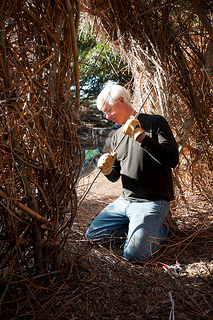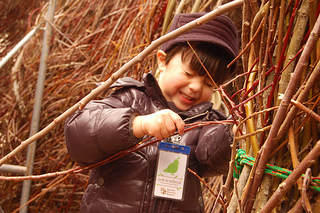By: Jessica Horowitz
 The Bay Area Discovery Museum recently welcomed internationally-known artist Patrick Dougherty to create a new sculpture to replace his first piece, located in the Museum’s Lookout Cove, a large outdoor exhibit space. Titled Peekaboo Palace, this new exhibit overlooks the Golden Gate Bridge. This immersive sculpture brings adults and children together through encouraging imaginary play.
The Bay Area Discovery Museum recently welcomed internationally-known artist Patrick Dougherty to create a new sculpture to replace his first piece, located in the Museum’s Lookout Cove, a large outdoor exhibit space. Titled Peekaboo Palace, this new exhibit overlooks the Golden Gate Bridge. This immersive sculpture brings adults and children together through encouraging imaginary play.
Led by Director of Visitor Experience and Exhibit Design Brianna Cutts, museum staff and volunteers worked together to create an interactive, one-of-a-kind sculpture for children to explore nature and art. According to Patrick, through working with sticks for many years he has “learned what birds already know.” “Patrick’s fascination with the interconnectedness of nature was inspiring to us all,” explained Brianna. Through volunteering, I was personally inspired by Patrick and I was curious to learn more about the collaboration between the museum and the artist. I recently had the opportunity to interview Brianna and reflect upon the overall construction process.
Is the Bay Area Discovery Museum the only children’s museum to have a work of art by Patrick Dougherty? Why do you think it’s important for kids to experience this type of art? What specifically attracts kids to this sculpture?
A. As far as I know, we are the only children’s museum with a Patrick Dougherty sculpture. I think it’s the unexpected use of a natural material that draws most people to Patrick’s sculptures. They have a quality that is simultaneously mysterious and magical. During his residency with us, Patrick would often say that all people have a relationship to sticks, that they are really something that we relate to on a primal level.
What are the benefits and/or challenges to constructing a piece like this on-site at the Bay Area Discovery Museum? How long did it take to complete the process? A. The benefits and challenges were the same: to watch a work in progress and ensure the safety of both the sculptors and the viewers. The process was amazingly quick: 16 days of sculpting, 8 hours a day, Patrick, his assistant Andy Lynch, and morning and afternoon shifts of four volunteers. So, it took about 1,200 hours to sculpt.
A. The benefits and challenges were the same: to watch a work in progress and ensure the safety of both the sculptors and the viewers. The process was amazingly quick: 16 days of sculpting, 8 hours a day, Patrick, his assistant Andy Lynch, and morning and afternoon shifts of four volunteers. So, it took about 1,200 hours to sculpt.
Similarly, were there any surprises that occurred during the construction that you had to address?
A. The great thing about this project is that it had a good plan, an adequate budget and a great team. I was fortunate to have about 18 months to plan and during that process talked with both staff and Patrick about what could be improved from the first process. During Patrick’s first sculpture, the site was still in construction and there were heavy rains, so Patrick had a challenging time and ended naming the first sculpture Haywire as a funny way to describe the process. It was my goal to avoid any “haywire episodes” for the second sculpture.
What was your experience like working with Patrick? How were museum staff/volunteers involved?
A. I had an amazing time working with Patrick, an opportunity I’ll always cherish. He is a genuinely collaborative and warm hearted person who takes great pride in his creations. I was also fortunate to have the support of two key staff members. Rose Kelly took on the role of Volunteer Coordinator, ensuring that all paperwork and communications happened seamlessly. Rick Roth took on the role of Construction Manager, overseeing the delivery of enormous loads of willow, and coordinating access to essential tools and materials. With such a short time frame, it was essential to divide up key tasks to ensure the work proceeded uninterrupted.
We also wanted to have children involved in the process. During the last week of the process, when the sculpture was formed, we asked children from our Not-A-School program to help us name the new sculpture. They came up with Peekaboo, which then Patrick modified to Peekaboo Palace.
While typically designed to last two-five years, Patrick’s first art piece at the Bay Area Discovery Museum, Haywire, lasted from 2004-2011. What do you predict will happen with Peekaboo Palace?
A. Some of the willow will take root and some of it will dry out. We’ve got a maintenance budget to ensure that we keep it thriving. Patrick’s pieces typically last 2-5 years. He was very impressed that we were able to maintain our first sculpture for seven years. We’re hoping we can maintain this new piece even longer.
For more information about Patrick Dougherty and Peekaboo Palace click on the link below:
http://www.baykidsmuseum.org/tour-the-museum/lookout-cove/patrick-dougherty-willow-sculpture/
http://www.stickwork.net/news.php
Jessica Horowitz is the Membership Manager at the Bay Area Discovery Museum. She earned her B.A. from Skidmore College in Saratoga Springs, N.Y. Currently, she is pursuing her dual M.A. in Museum Studies and M.B.A. at John F. Kennedy University.








Comments
It is great to see Patrick's work in a children's museum.
Add new comment